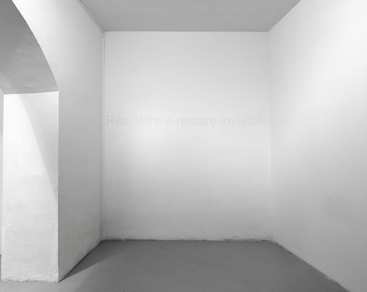
Born in Dugny, Seine-Saint-Denis, (FR). Lives and works in Berlin, Allemagne, (DE) and in Paris (FR).

2011
The sentece "To resist is to remain invisible" is written with white chalk on a white wall.
White chalk
Dimension variable
Éd. 2/3 + 1.A.P
Year of Purchase: 2013
“… I am trying to see, and to show viewers how to see, that the void is more than physical data in space. In my work, the void is never innocent. I use it as a vector of political meaning. I like to consider the void in my work as a function of its ‘history,’ as Michel Foucault would have said.” 1
Kader Attia, interviewed by Régis Durand in 2008
Photographs, sculptures, installations, films, slide shows; collages combining different materials or divergent times and spaces; pencil drawings capturing human figures in their social or religious identity, silhouettes of a globalized present; collected or recovered objects; elements of archives and architectures that touch on colonial and post-colonial history; saved books or news clippings… In Kader Attia’s work not only is there the protean and the “multi-medium,” but also a nearly insatiable accumulation of conflicting or syncretic forms, of de-contextualized materials, of dual-purpose devices. There is an accumulation of mental and political landscapes; of economic and religious landscapes (Hallal, 2004); of architectural landscapes that challenge the modernist gesture of one Le Corbusier in the context of an Arab-Muslim tradition; of myths and symbols of contemporary capitalism. Attia designs exhibitions following an aesthetic of oppositions and contraries and, for some years now, an aesthetic of reappropriation and what he himself calls of “reparation” (The Repair from Occident to Extra-Occidental Cultures, shown at dOCUMENTA 13 in Kassel, Germany, in 2012). In both his photos (La Piste d’atterrissage [Landing strip], 2003) and installations, which maintain a delicate balance between the monumental and the ephemeral (Flying Rats, Lyon Biennale, 2005; Holy Land, 2007; or Ghost, 2009), what is at stake is bodies, identities, sexualities, religions, exiles and exclusions, disappearances and absences, bodies of knowledge, breaks and exchanges between Western and non-Western cultures. Kader Attia’s primary material is the fragile, chaotic fullness of the world, the resistant side of which is this void, this presence in acts of violence, the wounds of an in-between. Wall writing in white chalk Résister c’est rester invisible (2011), conceived in the context of the Arab Spring, is barely visible to the viewer and may be traced in all the languages spoken where the scriptural installation is being presented; it evokes a philosophical position, which turns the act of resistance into an everyday underground act, a “natural, rather than cultural act.”2
Educated in the early 1990s at the École supérieure des Arts appliqués Duperré (Paris), then at the École nationale supérieure des Arts décoratifs de Paris, as well at the Escola de Artes Applicades “La Massana” (Barcelona), Kader Attia has experienced in his personal biography this in-betweenness which inspires his research: between the Arab-Muslim culture transmitted by his Algerian parents, who had emigrated to France, and Western culture which is both liberal and exclusionary… One must be in-between… in order to give shape to a possible reparation…
Marjorie Micucci
1 Exhibition catalog, Black & White: Sign of Times, Centro de Arte Contemporàneo Huarte, Huarte, Spain. Texts by Régis Durand, Octavio Zaya, Hannah Feldman, 2008.
2 From a statement by the artist made on the occasion of his solo exhibition Essential at Galleria Continua, San Gimignano, Italy, from February 11 to March 31, 2012.
The artist’s website: www.kaderattia.de
Further reading: Kader Attia RepaiR, ed. Léa Gauthier (Brussels: BlackJack Editions, 2014 English edition; 2015 French edition)